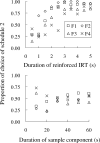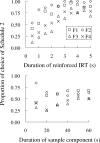Single-sample discrimination of different schedules' reinforced interresponse times
- PMID: 19794831
- PMCID: PMC2648525
- DOI: 10.1901/jeab.2009.91-157
Single-sample discrimination of different schedules' reinforced interresponse times
Abstract
Food-deprived rats in Experiment 1 responded to one of two tandem schedules that were, with equal probability, associated with a sample lever. The tandem schedules' initial links were different random-interval schedules. Their values were adjusted to approximate equality in time to completing each tandem schedule's response requirements. The tandem schedules differed in their terminal links: One reinforced short interresponse times; the other reinforced long ones. Tandem-schedule completion presented two comparison levers, one of which was associated with each tandem schedule. Pressing the lever associated with the sample-lever tandem schedule produced a food pellet. Pressing the other produced a blackout. The difference between terminal-link reinforced interresponse times varied across 10-trial blocks within a session. Conditional-discrimination accuracy increased with the size of the temporal difference between terminal-link reinforced interresponse times. In Experiment 2, one tandem schedule was replaced by a random ratio, while the comparison schedule was either a tandem schedule that only reinforced long interresponse times or a random-interval schedule. Again, conditional-discrimination accuracy increased with the temporal difference between the two schedules' reinforced interresponse times. Most rats mastered the discrimination between random ratio and random interval, showing that the interresponse times reinforced by these schedules can serve to discriminate between these schedules.
Keywords: interresponse-time reinforcement; lever press; random interval; random ratio; rats; variable interval; variable ratio.
Figures








Similar articles
-
Discrimination of variable schedules is controlled by interresponse times proximal to reinforcement.J Exp Anal Behav. 2012 Nov;98(3):341-54. doi: 10.1901/jeab.2012.98-341. J Exp Anal Behav. 2012. PMID: 23144509 Free PMC article.
-
Response-rate differences in variable-interval and variable-ratio schedules: An old problem revisited.J Exp Anal Behav. 1994 May;61(3):441-51. doi: 10.1901/jeab.1994.61-441. J Exp Anal Behav. 1994. PMID: 16812732 Free PMC article.
-
Schedule discrimination in a mixed schedule: implications for models of the variable-ratio, variable-interval rate difference.Behav Processes. 2008 May;78(1):10-6. doi: 10.1016/j.beproc.2007.11.008. Epub 2007 Dec 3. Behav Processes. 2008. PMID: 18178339
-
The copyist model of response emission.Psychon Bull Rev. 2012 Oct;19(5):759-78. doi: 10.3758/s13423-012-0267-1. Psychon Bull Rev. 2012. PMID: 22673925 Review.
-
Operant responding: Beyond rate and interresponse times.Brain Res Bull. 2022 Aug;186:79-87. doi: 10.1016/j.brainresbull.2022.05.009. Epub 2022 May 26. Brain Res Bull. 2022. PMID: 35644432 Review.
Cited by
-
Concurrent VR VI schedules: primacy of molar control of preference and molecular control of response rates.Learn Behav. 2010 Nov;38(4):382-93. doi: 10.3758/LB.38.4.382. Learn Behav. 2010. PMID: 21048229
-
Discrimination of variable schedules is controlled by interresponse times proximal to reinforcement.J Exp Anal Behav. 2012 Nov;98(3):341-54. doi: 10.1901/jeab.2012.98-341. J Exp Anal Behav. 2012. PMID: 23144509 Free PMC article.
References
-
- Ferster C.B, Skinner B.F. Schedules of reinforcement. New York: Appleton-Century-Crofts; 1957.
-
- Peele D.B, Casey J, Silberberg A. Primacy of interresponse-time reinforcement in accounting for rate differences under variable-ratio and variable-interval schedules. Journal of Experimental Psychology: Animal Behavior Processes. 1984;10:149–167.
MeSH terms
LinkOut - more resources
Full Text Sources

